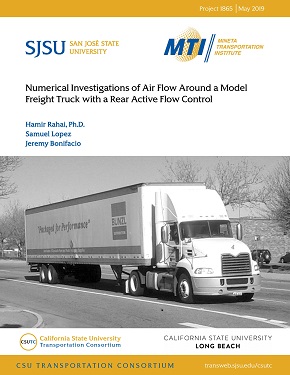- 408-924-7560
- mineta-institute@sjsu.edu
- Donate
Numerical Investigations of Air Flow Around a Model Freight Truck with a Rear Active Flow Control
We performed numerical and experimental investigations of aerodynamic characteristics of a modified Ahmed body with two trailing vertical rotating cylinders. The freestream mean velocity was 24.5 m/sec. (55 MPH) for the numerical investigations and 16.67 m/sec. (37.4 MPH) for the experiments. For the numerical investigations, two 5 cm-diameter vertical cylinders were placed on the back side of the model, protruding 1/8 diameter into the freestream and 1/8 diameter from the back. The cylinders extend the height of the model and rotating in the opposite direction, injecting momentum into the back of the Ahmed body. The simulations were performed at three different rotation rates, with velocity ratios (λ) of 0.5, 1, and 2, where the velocity ratio λ is defined as the ratio of axial tangential mean velocity at the cylinder’s surface to the freestream mean velocity. Simulations of Reynolds-Averaged Navier-Stokes Equations (RANS) were performed with the K-ω Shear-stress transport turbulence model. Approximately 15 million unstructured polyhedral cells were used for each simulation. The numerical results indicate that at a velocity ratio of 0.5, with rotating cylinders, the overall drag is reduced by nearly 4%. However at the velocity ratios of 1 and 2, the drag coefficient was increased. Reviewing flow details indicates that at high velocity ratios, the freestream flow overshoots the rotating cylinders, creating reduced back pressure and thus increased the overall drag.
The experimental verifications of the numerical results were performed in the CSULB/Boeing low-speed wind tunnel with velocity ratios of 0.3, and 0.6 (higher velocity ratios were not investigated due to difficulty of maintaining a high rotation rate). Results indicate more than 5% drag reduction at the velocity ratio of 0.3, and nearly 8% reduction at the velocity ratio of 0.6. The reduction in the drag force corresponds to increase in the average back pressure.
HAMID RAHAI, PhD
Dr. Hamid Rahai is a professor of Departments of Mechanical and Aerospace Engineering & Biomedical Engineering and is Associate Dean for Research and Graduate Studies in the College of Engineering at CSULB. He has taught various classes at both undergraduate and graduate levels in the areas of fluid dynamics, thermodynamics, heat transfer, instrumentation, numerical methods, and turbulence. He has supervised over 65 MS theses and projects and PhD dissertations and has published more than 90 technical papers. He has received in excess of 6 million dollars in grants and contracts from the National Science Foundation, Federal Highway Administration, California Energy Commission, California Air Resources Board, Port of Los Angeles, Caltrans, Boeing Company, Southern California Edison, Long Beach Airport, Long Beach Transit, among others. He has been granted a patent for development of a high efficiency vertical axis wind turbine (VAWT) and another patent with Via Verde Company on wind turbine apparatus. He also has a pending patents related to a new diagnostic system for lung diseases using CFD, a new CVG tape for reducing drag of aircraft and wind turbine blades, and a provisional patent based on current study, reducing drag of trailers with rotating cylinders. For the past 25 years he has been a consultant to the local energy and aerospace industries. Dr. Rahai is the recipient of several Scholarly and Creative Activities Awards, including the 2012 CSULB Impact Accomplishment of the Year in Research, Scholarly, and Creative Activities Award, the 2002–2003 CSULB Distinguished Faculty Scholarly and Creative Activities Award, and the 2004 Northrop Grumman Excellence in Teaching Award. In 2014, Dr. Rahai received the Outstanding Engineering Educator Award from the Orange County Engineering Council in California and in 2019 he was inducted as a senior member of the National Academy of Inventors (NAI).
SAMUEL LOPEZ
Samuel Lopez is a graduate research assistant at the Center for Energy and Environmental Research & Services (CEERS) in the College of Engineering at California State University, Long Beach (CSULB). He is expected to receive his MSME degree in May 2019.
JEREMY BONIFACIO
Jeremy Bonifacio is a graduate research associate and a part-time Lecturer at the Center for Energy and Environmental Research & Services (CEERS) in the College of Engineering at California State University, Long Beach (CSULB). He is a PhD student in the joint PhD program in Engineering and Computational Mathematics between CSULB College of Engineering and Claremont Graduate University (CGU) Mr. Bonifacio has authored and co-authored more than 11 technical papers and is recipient of CSULB innovation challenge award in 2016. He is expected to receive his PhD degree in June 2019.
-
Contact Us
San José State University One Washington Square, San Jose, CA 95192 Phone: 408-924-7560 Email: mineta-institute@sjsu.edu






